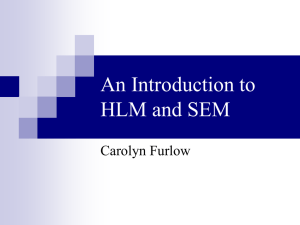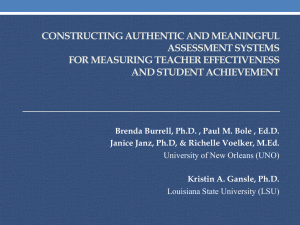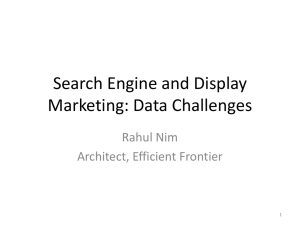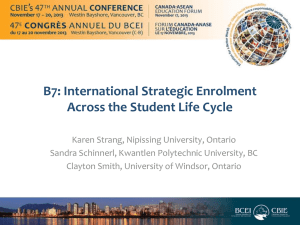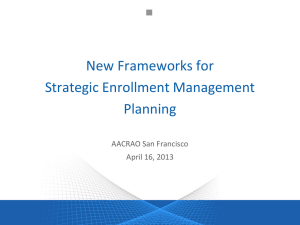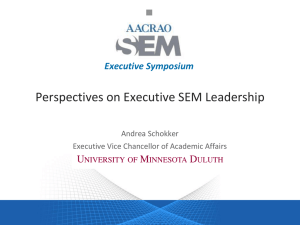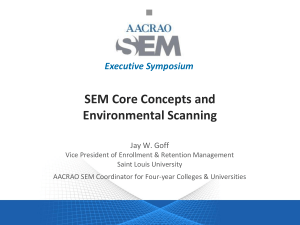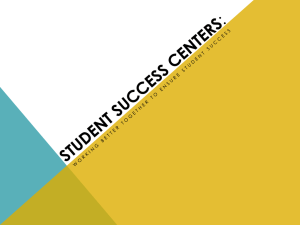SEM and the Academic Enterprise
advertisement
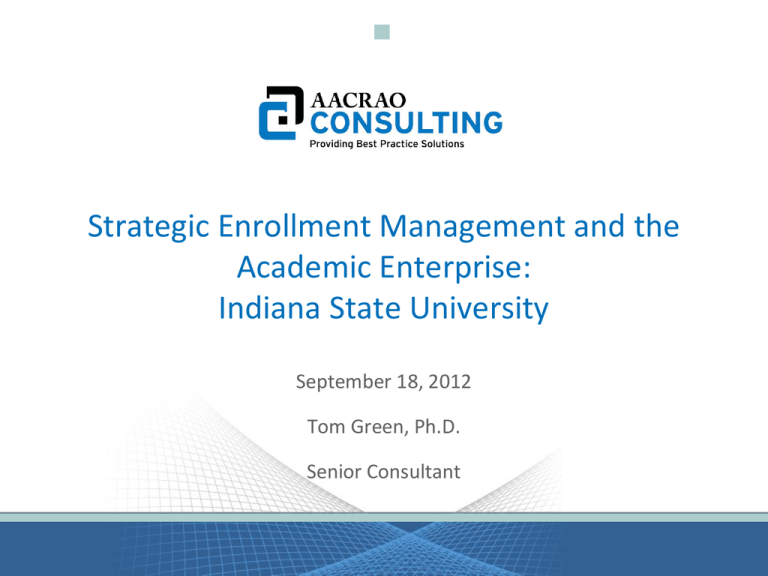
Strategic Enrollment Management and the Academic Enterprise: Indiana State University September 18, 2012 Tom Green, Ph.D. Senior Consultant Overview 1. Ground rules 2. SEM reminders 3. Academics as a choice factor among prospective students 4. Remediation 5. The changing nature of academic advising 6. Articulation and community college partnerships PlaceIndiana the titleState and date of the presentation here SEM and the Academic Enterprise, University, September 2012 2 2 Ground rules for the session 1. This is an open discussion – not a lecture 2. Make sure to ask questions as we go – There are several topics and waiting until the end may miss an important point 3. The information today is taken from: – Higher education research – Current practice among SEM professionals – My own observations from working with colleges and universities across all sectors of higher education in the U.S., Canada and the UK PlaceIndiana the titleState and date of the presentation here SEM and the Academic Enterprise, University, September 2012 3 3 What is Strategic Enrollment Management (SEM)? Strategic enrollment management is a concept and process that enables the fulfillment of institutional mission and students’ educational goals. PlaceIndiana the titleState and date of the presentation here SEM and the Academic Enterprise, University, September 2012 4 4 The Purposes of SEM are Achieved by… 1. Establishing clear goals for the number and types of students needed to fulfill the institutional mission 2. Promoting students’ academic success by improving access, transition, persistence, and graduation 3. Promoting institutional success by enabling effective strategic and financial planning 4. Creating a data-rich environment to inform decisions and evaluate strategies PlaceIndiana the titleState and date of the presentation here SEM and the Academic Enterprise, University, September 2012 5 5 The Purposes of SEM are Achieved by… 5. Improving process, organizational and financial efficiency and outcomes 6. Strengthening communications and marketing with internal and external stakeholders 7. Increasing collaboration among departments across campus to support the enrollment program PlaceIndiana the titleState and date of the presentation here SEM and the Academic Enterprise, University, September 2012 6 6 SEM Planning Framework Sustainable Enrollment Outcomes Tactics Strategies Campus Infrastructure Strategic Enrollment Goals Data Collection and Analysis Key Enrollment Indicators Institutional Strategic Plan PlaceIndiana the titleState and date of the presentation here SEM and the Academic Enterprise, University, September 2012 7 7 SEM Process Framework Performed by Process steps Align institutional strategic plan with broad enrollment targets and desired mix of students Develop action steps, accountability, and metrics Implement action steps Monitor progress, Report results to campus and executive leadership Mid-course adjustments New or revised goals Approve strategic goals and enrollment projection models Changes to goals Use data and information results to establish focused goals each for recruitment, retention, service, etc., and enrollment projection models Additional requests, clarifying questions Data and information gathering and assessment: Internal culture/ environment, student enrollment behaviors and scan of external environment President Bradley’s Cabinet, SEM Steering Committee Data Team Goals recommended by Recruitment Council and Student Success Council; models developed by Data Team President Bradley’s Cabinet, SEM Steering Committee SEM councils and sub-committees Appropriate staff and faculty departments SEM Steering Committee PlaceIndiana the titleState and date of the presentation here SEM and the Academic Enterprise, University, September 2012 8 8 Why do students go to college? 1. Students have long been attracted to higher education as a means to pursue ideas and interests that matter to them. 2. The role of academic program quality and availability is vital in student choice. 3. The issues that the list as driving them to attend college almost all revolve around the pursuit of an academic major. 4. The pursuit of culture and ideas, however, are not lost in this mix of factors. 5. Quiz time: – What percent of college freshmen say that gaining a general education and an appreciation of ideas is an important reason to attend college? PlaceIndiana the titleState and date of the presentation here SEM and the Academic Enterprise, University, September 2012 9 9 Changing values for going to college Source: Pryor, J. H., DeAngelo, L., Palucki Blake, L., Hurtado, S., & Tran, S. (2011). The American freshman: National norms fall 2011. Los Angeles: Higher Education Research Institute, UCLA. PlaceIndiana the titleState and date of the presentation here SEM and the Academic Enterprise, University, September 2012 10 10 Reasons students choose a particular college or university Source: Pryor, J. H., DeAngelo, L., Palucki Blake, L., Hurtado, S., & Tran, S. (2011). The American freshman: National norms fall 2011. Los Angeles: Higher Education Research Institute, UCLA. PlaceIndiana the titleState and date of the presentation here SEM and the Academic Enterprise, University, September 2012 11 11 What motivates high-achieving students to come? 1. Quality of individual programs beyond overall institutional reputation: – They are interested in specific program strengths. 2. Opportunities for student research at the undergraduate level. 3. Opportunities to have a close and meaningful relationship with a faculty member (mentoring experiences). 4. While they likely expect to receive them or may not need them as much, high-achieving students rate finances and scholarships much lower on the list than these other factors. Source: Lipman-Hearne and Associates (2006). High-Achieving Seniors and the College Decision. Chicago, PlaceIndiana the titleState and date of the presentation here SEM and the Academic Enterprise, University, September 2012 12 12 What does this mean for academic programs? 1. Web sites must be relevant and contain information that helps students understand their key issues: – Program quality – Success of graduates – Opportunities for undergraduate research 2. Hearing from faculty during the search process is pivotal in influencing enrollment decisions: – Today’s students are savvy and want to hear from faculty, not just counselors – Prospective student events should be taken seriously. 3. Work closely through admissions to provide information and resources for prospective students. PlaceIndiana the titleState and date of the presentation here SEM and the Academic Enterprise, University, September 2012 13 13 Remediation 1. Starting in the 1960’s, the United States changed long-held views on who should attend college: – “Massification” – Students who previously had been denied access. – Affordability programs funded by the federal and state governments. 2. As growing numbers of students anticipated that they would need to attend college and more of them entered, it also meant that many were unprepared for the rigors of this level. 3. Admissible ≠ Prepared 4. Estimates of spending on remediation today in the United States are somewhere between $10 – 12 billion. PlaceIndiana the titleState and date of the presentation here SEM and the Academic Enterprise, University, September 2012 14 14 Student academic aspirations are out of sync with behaviors that would prepare them for college-level work 1 in 4 anticipates needing math help Minority of students exhibited behaviors we expect in college More time spent in online networks than leisure reading Source: Pryor, J. H., DeAngelo, L., Palucki Blake, L., Hurtado, S., & Tran, S. (2011). The American freshman: National norms fall 2011. Los Angeles: Higher Education Research Institute, UCLA. PlaceIndiana the titleState and date of the presentation here SEM and the Academic Enterprise, University, September 2012 15 15 So how do we help students learn what we expect from them? 1. “Sink or swim” is gone: – The public expects us to help students succeed for the price they are paying for tuition and fees. – Accountability in higher education is shifting from access to attainment. 2. How do we know what works? PlaceIndiana the titleState and date of the presentation here SEM and the Academic Enterprise, University, September 2012 16 16 Hossler and Kalsbeek Analysis, 2010 Over recent decades, student retention has been one of the most studied aspects of college enrollment…with abundant articles and journals, studies and dissertations, models and theories, practices and programs, consultancies and conferences all devoted to improving retention and rates of degree completion… Despite this, in terms of overall rates of degree completion… If anything, 4- and 6-year graduation rates have declined… College & University Journal, vol. 85, no. 3 PlaceIndiana the titleState and date of the presentation here SEM and the Academic Enterprise, University, September 2012 17 17 Hossler and Kalsbeek Analysis, 2010 Key factors in retention success Adequate coordination − Time and resources devoted to retention − Level and authority of the chief retention officer and committees Data − Often new initiatives are not assessed for effectiveness − The importance of “action research” Broadening focus from “high-risk students” to “high-risk experiences” − Could be courses or transaction points PlaceIndiana the titleState and date of the presentation here SEM and the Academic Enterprise, University, September 2012 18 18 Hossler Study, 2005 Analysis of retention literature between 1980 and 2002 Prevalence of the: laundry list model – Based on • usually non-empirical analyses testing theoretical models • propositional literature, practitioner articles on what they believe should improve student persistence – A quick scan of campus reveals “we are doing almost everything we should be doing to enhance student persistence. We have academic advising, we have orientation, we have career planning offices, we have learning communities, we have academic support centers, we have culture centers for students of color, and our faculty have frequent interactions with our students.” College & University Journal, vol. 81, no. 2 PlaceIndiana the titleState and date of the presentation here SEM and the Academic Enterprise, University, September 2012 19 19 Hossler Study, 2005 Found only 16 empirical studies of institutional efforts to improve persistence published in mainline higher education journals Multiple studies reported positive effects from: – Supported instruction targeted at courses in which many students evidenced poor levels of academic performance – Transition/orientation/university 101 programs – Programs to enhance student-faculty interaction PlaceIndiana the titleState and date of the presentation here SEM and the Academic Enterprise, University, September 2012 20 20 Summer bridge programs 1. Currently serving as the external evaluator and consultant to a program for low-income, first-generation students: – Admissible but ill-prepared for college work. – Most need two semesters of remediation before ready for freshman courses. – Most are students of color from urban areas. 2. Summer bridge program implemented in 2010: – Six-week skills building courses. – No tuition fees for students (grant funded). – Peer mentoring on academic success, time management and “college knowledge”. – Close advising support through the first year of studies. PlaceIndiana the titleState and date of the presentation here SEM and the Academic Enterprise, University, September 2012 21 21 First-year retention results 90.00% 80.00% 60.00% Implementation of recommendations Initial known status of retention rates with AACRAO hired to help enrollment 70.00% 59.90% Results achieved Retention study and recommendations developed 63.20% 77.60% 66.80% 67.60% Fall 2008 Fall 2009 50.00% 40.00% 30.00% 20.00% 10.00% 0.00% Fall 2006 Fall 2007 Fall 2010 PlaceIndiana the titleState and date of the presentation here SEM and the Academic Enterprise, University, September 2012 22 22 Academic advising in today’s environment 1. Two types of advising (NACADA): – Prescriptive – Developmental 2. Technological impact on advising roles: – Web site – Degree pathway sites – Degree audit 3. What is the role today for an academic adviser? 4. Possible roles: – Referrals to help or services. – Mentoring/guidance on how courses and degrees prepare students for next steps/graduate programs/careers. PlaceIndiana the titleState and date of the presentation here SEM and the Academic Enterprise, University, September 2012 23 23 Additional impact of degree audit systems 1. Degree requirements are programmed into a system that can check completion of courses and requirements: – This eliminates the need to check degree completion manually or “certify” degrees in academic departments. – The requirements are approved once and every time they change. 2. Students expect that all changes to published requirements are processed immediately: – Petitions (substitutions and waivers). – Transfer credit. – Credit by exam. 3. Information cannot be “held” in the department for processing at graduation. PlaceIndiana the titleState and date of the presentation here SEM and the Academic Enterprise, University, September 2012 24 24 New patterns of starting college Source: Hossler, et. al. (2012). Transfer and Mobility: A National View of Pre-Degree Student Movement in Postsecondary Institutions Bloomington, IN, National Student Clearinghouse Research Center. PlaceIndiana the titleState and date of the presentation here SEM and the Academic Enterprise, University, September 2012 25 25 How many students transfer? Source: Hossler, et. al. (2012). Transfer and Mobility: A National View of Pre-Degree Student Movement in Postsecondary Institutions Bloomington, IN, National Student Clearinghouse Research Center. PlaceIndiana the titleState and date of the presentation here SEM and the Academic Enterprise, University, September 2012 26 26 Where do they start and where do they go? Source: Hossler, et. al. (2012). Transfer and Mobility: A National View of Pre-Degree Student Movement in Postsecondary Institutions Bloomington, IN, National Student Clearinghouse Research Center. PlaceIndiana the titleState and date of the presentation here SEM and the Academic Enterprise, University, September 2012 27 27 A permeable higher education environment 1. As we created a permeable system of higher education in the United States, students took advantage of it: – It purports to provide a set of equivalent courses across higher education. 2. What we have not standardized are the expectations of quality and depth of coverage across courses that appear to have similar content and learning outcomes. 3. This creates a mismatch: – Students assume that earning credit in a course means they are prepared. – Faculty assume that students are prepared when they enter their courses. PlaceIndiana the titleState and date of the presentation here SEM and the Academic Enterprise, University, September 2012 28 28 How articulation is improving the situation 1. Matching course equivalencies across institutions provides the initial raw material for students to find their way across institutions. 2. 2+2 or 60+60 programs are the next step: – They provide a pathway of courses that minimize the costs and time required to earn a degree across two institutions. – The most difficult aspect of these programs is getting information into students’ hands before they seek transfer. 3. These steps still do not bridge the gaps in expectations. PlaceIndiana the titleState and date of the presentation here SEM and the Academic Enterprise, University, September 2012 29 29 Partnership programs 1. Institutions sign agreements to collaborate on a number of issues regarding transfer credits. 2. Faculty groups work together to establish common learning outcomes: – These are often very small changes to community college courses that increase the alignment between content and expectations. – This work often results in greater collaboration between academic departments at the partner institutions: • Guest lectures. • Attendance at special events/speakers. 3. Promotion of pathway information to community college students. PlaceIndiana the titleState and date of the presentation here SEM and the Academic Enterprise, University, September 2012 30 30 Additional collaborative efforts 1. Housing – Allows community college partnership students to live at the fouryear institution. 2. Campus access – Library – Athletic events (or access to tickets) – Student clubs and organizations 3. Reverse transfer – Allows students to earn an associate’s degree along the way if they transfer to the four-year partner before earning it at the community college. PlaceIndiana the titleState and date of the presentation here SEM and the Academic Enterprise, University, September 2012 31 31 Thank you! Tom Green, Ph.D. Senior Consultant Tom.Green@aacrao.org consulting.aacrao.org PlaceIndiana the titleState and date of the presentation here SEM and the Academic Enterprise, University, September 2012 32 32
